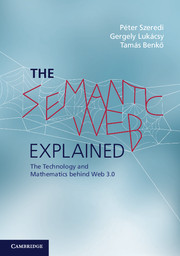Introduction
Published online by Cambridge University Press: 05 August 2014
Summary
The Semantic Web is a new area of computer science that is being developed with the main aim of making it easier for computers to process intelligently the huge amount of information on the web. In other words, as the common slogan of the Semantic Web says: computers should not only read but also understand the information on the web. To achieve this, it is necessary to associate metadata with web-based information. For example, in the case of a picture one should formally provide information regarding its author, title and contents. Furthermore, computers should be able to perform reasoning tasks. For example, if it is known that a river appears in a picture, the computer should be able to deduce that water can also be found in the picture.
Research into hierarchical terminology systems, i.e. ontologies, is strongly connected to the area of the Semantic Web. Ontologies are formal systems that allow the description of concrete knowledge about objects of interest as well as of general background knowledge. The description logic formalism is the most widespread approach providing the mathematical foundation of this field. It is not a coincidence that both OWL and its second edition, OWL 2, which are Semantic Web languages standardised by the World Wide Web Consortium (W3C), are based on Description Logic.
- Type
- Chapter
- Information
- The Semantic Web ExplainedThe Technology and Mathematics behind Web 3.0, pp. 1 - 6Publisher: Cambridge University PressPrint publication year: 2014



